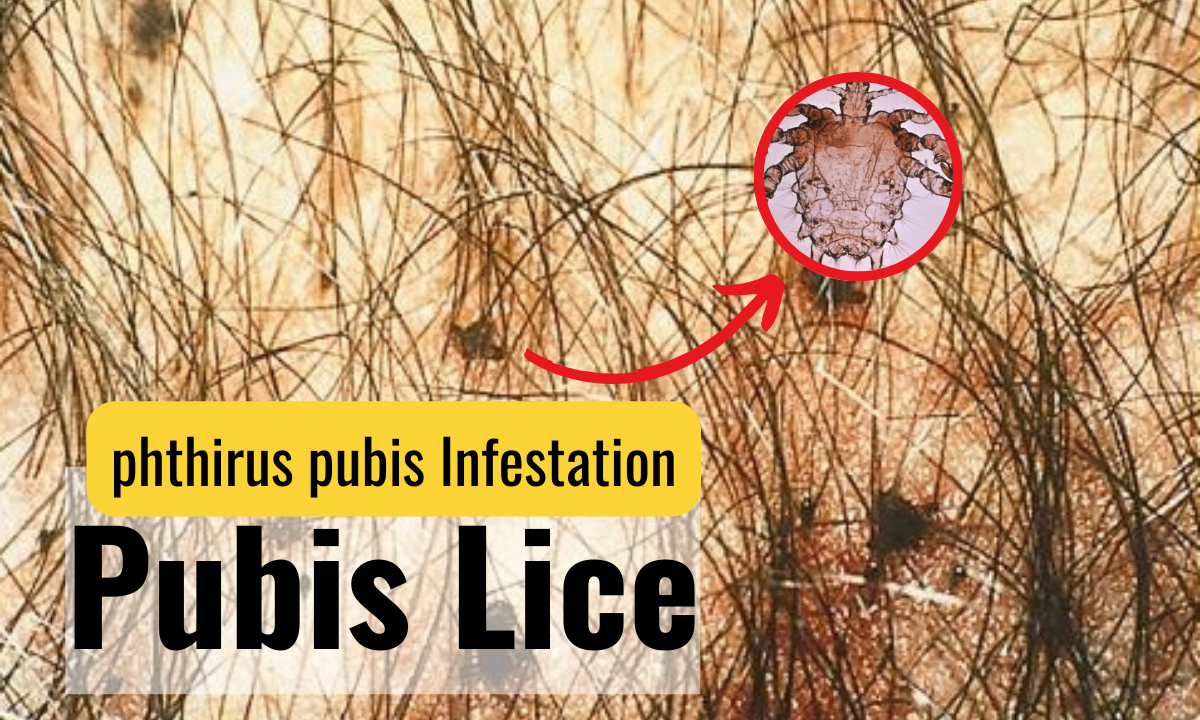Outline of the Article
- Introduction to Phthirus Pubis Infestation

- What is Phthirus Pubis?
- Importance of Understanding Phthirus Pubis Infestation
- Causes of Phthirus Pubis Infestation
- Transmission Routes
- Risk Factors
- Symptoms of Phthirus Pubis Infestation
- Physical Symptoms
- Emotional Impact
- Diagnosis of Phthirus Pubis Infestation
- Physical Examination
- Laboratory Tests
- Treatment Options
- Medications
- Home Remedies
- Prevention Strategies

- Safe Sexual Practices
- Personal Hygiene
- Complications
- Secondary Infections
- Psychological Effects
- Myths and Facts About Phthirus Pubis Infestation
- Impact on Public Health
- Global Burden
- Public Awareness Campaigns
- Support and Resources
- Support Groups
- Educational Materials
- Research and Future Directions

- Ongoing Studies
- Potential Breakthroughs
- Conclusion
- Recap of Key Points
- Importance of Early Detection and Treatment
Understanding phthirus pubis Infestation: Treatment, Causes, Symptoms, and Prevention
Introduction to Phthirus Pubis Infestation
phthirus pubis, commonly known as pubic lice or crabs, is a parasitic infestation affecting the pubic hair region and other coarse body hair. Understanding this condition is vital due to its prevalence and potential complications. Read more..
Causes of Phthirus Pubis Infestation
phthirus pubis infestation spreads through close personal contact with an infected individual or infested clothing or bedding. Various factors increase the risk of contracting this condition, including frequent changes in sexual partners and poor personal hygiene.
Symptoms of Phthirus Pubis Infestation
The primary symptom of phthirus pubis infestation is intense itching in the affected area. Other physical symptoms may include the presence of small, red bumps or blue spots on the skin. Additionally, the emotional impact of dealing with this condition can be distressing for affected individuals.
Diagnosis of Phthirus Pubis Infestation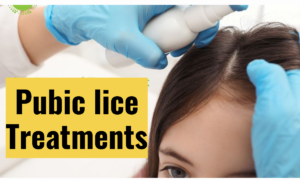
Diagnosing phthirus pubis infestation typically involves a physical examination of the affected area by a healthcare professional. In some cases, laboratory tests may be conducted to confirm the presence of lice or their eggs.
Treatment Options
Several medications, such as topical creams and shampoos containing insecticides, are available to treat phthirus pubis infestation. Additionally, home remedies like combing the affected area with a fine-toothed comb and washing infested clothing and bedding in hot water can help eliminate the parasites.
Prevention Strategies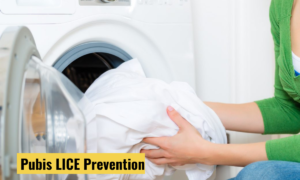
Preventing phthirus pubis infestation involves practicing safe sexual practices, including using condoms and limiting sexual partners. Maintaining good personal hygiene, such as regularly washing and inspecting the pubic hair region, can also reduce the risk of infestation.
Complications
Left untreated, phthirus pubis infestation can lead to secondary bacterial infections and skin irritation. Moreover, the psychological effects of dealing with this condition, such as embarrassment and anxiety, can impact an individual’s quality of life.
Myths and Facts About Phthirus Pubis Infestation
There are several misconceptions surrounding phthirus pubis infestation, including the belief that it only affects individuals with poor hygiene habits. It’s essential to clarify these myths and provide accurate information about the condition.
Impact on Public Health
Phthirus pubis infestation is a global health concern, with millions of cases reported annually worldwide. Public health initiatives aimed at raising awareness about this condition and promoting preventive measures are crucial for controlling its spread.
Support and Resources
Support groups and educational materials are available to help individuals affected by phthirus pubis infestation cope with their condition. These resources offer guidance and support for managing symptoms and preventing reinfestation.
Research and Future Directions
Ongoing research into phthirus pubis infestation focuses on developing more effective treatment options and understanding its epidemiology. Future breakthroughs in this field could lead to better strategies for prevention and control.
Conclusion
Phthirus pubis infestation is a common parasitic condition that can have significant physical and emotional effects on affected individuals. By understanding its causes, symptoms, and treatment options, individuals can take proactive steps to prevent and manage infestation, thereby improving their overall well-being.
FAQs (Frequently Asked Questions)
- Can phthirus pubis infestation affect other parts of the body besides the pubic region?
- Yes, although less common, phthirus pubis infestation can affect other areas with coarse body hair, such as the armpits and chest.
- Are over-the-counter treatments effective in treating phthirus pubis infestation?
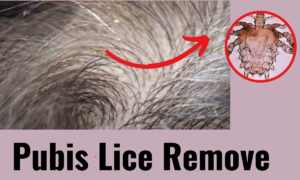
- In many cases, over-the-counter medications containing insecticides can effectively eliminate pubic lice. However, severe infestations may require prescription-strength treatments.
- Can phthirus pubis infestation be prevented entirely?
- While it may not be possible to prevent phthirus pubis infestation entirely, practicing safe sexual practices and maintaining good personal hygiene can significantly reduce the risk of infestation.
- Is phthirus pubis infestation a sexually transmitted infection (STI)?
- Yes, phthirus pubis infestation is considered a sexually transmitted infection, as it is primarily spread through close personal contact, including sexual activity.
- How long does it take to treat phthirus pubis infestation?
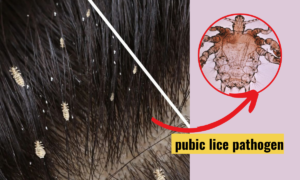
- With prompt and proper treatment, phthirus pubis infestation can typically be resolved within a few weeks. However, it’s essential to follow treatment guidelines and take preventive measures to avoid reinfestation.
- What is the disease caused by Phthirus pubis ?
- The cause of pediculosis pubis, also known as phthiriasis, is infection with Phthirus pubis, a type of crab louse that causes around 3 million cases of pediculosis annually in the United States, along with head louse infections. To get the right diagnosis, a thorough physical examination, a history, and a high degree of suspicion are required.
- How do I get rid of Phthirus pubis ?
- Washing or shaving will not remove pubic lice because they just require a small amount of hair to lay their eggs. As a result, you don’t need to shave your underarms. An insecticidal lotion or cream that is sold over-the-counter at pharmacies can be used as self-care at home.
- What are three symptoms of pubic lice ?
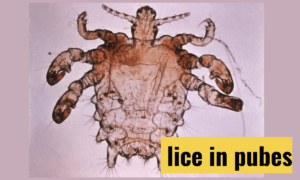
- Examine your body for signs of pubic lice infestation, which typically worsens at night.
- little reddish-blue patches on your body caused by lice bites
- The white or yellow specks on your hair are called lice eggs.
- dark crimson or brown (lice poop) stains on your underpants
- impacted eyelashes that are sticky or crusty.
- How is pubic lice harmful ?
- There is no known disease that pubic (“crab”) lice can spread. The most typical sign of a pubic lice infestation is itching (also known as “pruritus”) in the pubic and groin area. Similar to previous lice infections, severe itching results in scratching, which can lead to skin ulcers and a subsequent bacterial infection.
- What disease is caused by Pediculus sp ?
- Human Pediculosis is a condition caused by body and head lice (Pediculus humanus humanus and P. h. capitis, respectively). While head lice typically live on the head and face, body lice mostly inhabit the torso, yet both species are known to move about.
- What is an infestation caused by Pediculus ?
- Pediculosis is the term for the infestation of clothing or hairy areas of the body with lice eggs, larvae, or adults. This insect’s crawling stages can cause excruciating itching since they feed on human blood. Body lice are typically found along clothing seams, crab lice in the pubic region, and head lice on the scalp.
- Phthirus pubis labelled diagram ?
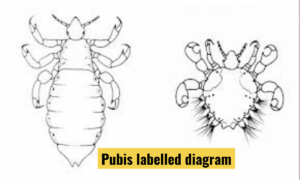
- Phthirus pubis treatment ?
- Pubic (“crab”) lice can be treated with a mousse containing pyrethrins and piperonyl butoxide or a lotion with 1% permethrin. These products can be purchased at your neighborhood pharmacy or drugstore over-the-counter without a prescription.
- phthirus pubis infestation treatment ?
- Lice infestations may be eliminated by following these steps:
- Apply shampoos and lotions. Select from a variety of over-the-counter lice-killing creams and
- shampoos (Nix, among others).
- Clean any contaminated materials. Clean the clothes, towels, and bedding that you used in the two
- days before treatment.
- Pack away washable items or dry clean them.
- Phthirus pubis symptoms ?
- Among the symptoms include pruritus, or intense itching in regions with hair,
- particularly the pubic hair.
- irritated skin from lice bites that may seem red or bloody.
- Black lice droppings on your underpants in small spots.
- Little, difficult-to-remove white specks on pubic hair that are lice eggs. More..
- Pthirus pubis disease ?
- A pubic louse infestation, Pediculosis pubis (sometimes called “crabs” or “pubic lice”) is caused by the wingless Pthirus pubis pubic louse, which feeds on blood and lays its eggs (nits) mostly on pubic hair. Hair around the anus, underarm, beard, eyebrows, moustache, and eyelashes may be affected less frequently.
- What type of disease is pubic lice ?
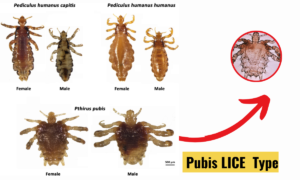
- There is no known disease that pubic (“crab”) lice can spread. The most typical sign of a pubic lice infestation is itching (also known as “pruritus”) in the pubic and groin area. Similar to previous lice infections, severe itching results in scratching, which can lead to skin ulcers and a subsequent bacterial infection.
- How long is the life cycle of pubic lice ?
- After roughly six to eight days, the eggs hatch. The young lice then go through three more stages until they reach adulthood. It takes roughly 23 days to mature from an egg. After being taken from a human host, adults cannot survive for more than twenty-four hours.
Reference :
- https://en.wikipedia.org/wiki/Pediculosis_pubis
- https://www.ncbi.nlm.nih.gov/pmc/articles/PMC6243192/#:~:text=Phthirus%20pubis%20Linnaeus%2C%201758%20(Diptera,%2C%20chest%2C%20axillae%20and%20beard.
- https://www.ncbi.nlm.nih.gov/pmc/articles/PMC10460172/
- https://www.cdc.gov/dpdx/pthiriasis/index.html
- https://www.sciencedirect.com/topics/medicine-and-dentistry/pubic-pediculosis
- https://www.sciencedirect.com/topics/biochemistry-genetics-and-molecular-biology/phthirus
- https://www.healthline.com/health/std/pubic-lice
- https://my.clevelandclinic.org/health/diseases/4522-pubic-lice-crabs
